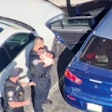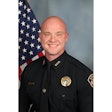It was 12:42 a.m., June 3, 1997, and Officer Malcom Thompson, of the Kissimmee (Fla.) Police Department, was investigating a suspicious person report. He noticed someone who matched the description standing next to a cab, using the phone booth at the convenience store. Thompson, a 25- year veteran of police work, recognized him as a local criminal, who had been discussed as a possible suspect in a recent string of hold-ups.
I notified dispatch that I was on the way to back offer officer backup as they confirmed the suspect was indeed wanted for armed robbery.
Earlier in the evening, the suspect had robbed two tourists, then carjacked a cab driver, whom he was holding hostage as he talked on the phone. He was armed with an eight-shot, .22- caliber revolver.
Thompson went to go hands-on with the suspect. No, he didn't wait for back-up. No, he didn't draw his firearm. He told the suspect that he was going to have to come with him.
The suspect shouted, "Fuck you, cop! I'm not going back to prison!" and pulled the revolver out of a pocket. He shot at Thompson six times. Three of the shots hit the officer in the head, throat and chest. The suspect then got into the cab, placed the revolver against the head of the cab driver and demanded he drive away.
Despite being hit by what doctors would later call three fatal shots, Thompson did not surrender. He approached the ca, weapon now drawn, and fired six rounds at the suspect, who had climbed into the back seat of the cab and was trying to escape out the opposite side door.
Thompson's left eye was shattered, his left lung had collapsed, and he was bleeding profusely from the throat wound, but he continued around the cab. When he saw the suspect, with the revolver still clutched in his had, attempting to crawl out of the bad, Thompson fired six more times. Every police round fired was accounted for. They had all hit the suspect, who died in the parking lot- with two live rounds in his revolver.
As another officer and I applied direct pressure to his massive wounds and called for Fire Rescue, Thompson kept asking us if the bad guy was down. He was concerned for the safety of responding officers. He told me he wanted his wife to come to the scene. He asked if his dog was all right.
While we tried to comfort out colleague, our squad members converged on the location. They began securing the crime scene, identifying evidence, contacting witnesses and setting up a landing zone for the medevac helicopter.
A few minutes later, the Fire Rescue guys arrived in the Orange County Sheriff's Office helicopter, Chase One, and began emergency medical treatment. Thompson was then airlifted to a waiting surgical team that worked for hours to stabilize him.
The Osceola County Sheriff's Office began helping us answer our calls for service, filling in for officers and dispatchers who were busy, dealing with the tasks associated with an investigation involving a critically injured officer and officer shooting. Overall, it was an impressive display of teamwork.
Though Thompson lost the use of his left eye, and will not likely be able to return to full police duty, he survived and is still as tough as ever. He freely admits his mistakes. But Thompson displayed what we try to teach recruits in the academy, and new officers in the F.T.O. program: the will to survive.
Hopefully Thompson, a defensive tactics and firearms instructor, will be able to talk about his experience with new recruits. For my part, whenever I teach officer survival in the academy or meet a new officer who didn't know him, I'll point to one of my partners and say, "That's a hero. That's a cop."
Commander Russell Barnes, an 18- year veteran of law enforcement, currently works with the Kissimmee, Fla., Police Department. He is currently assigned to the professional standard division.












